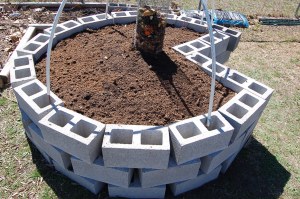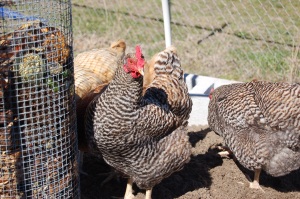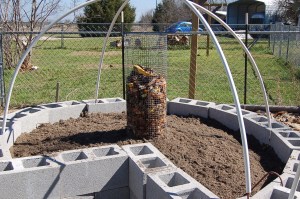These are all facts:
- We live in Central Texas
- Summers here are brutally hot.
- We are in the midst of a drought.
- My garden dies in the heat of the summer.
- Poodles trimmed to resemble bonsai trees are funny.
The first four facts relate to this post. The last one makes me laugh. Poor poodles. I would say I’m laughing with them, but I’ve never seen a dog laugh. Maybe they aren’t big on laughing out loud. Come to think of it, I’ve never received a text from a dog saying “lol” or more likely, “rotfl”.
I’m easily distracted.
This post is about gardening, not dogs. Specifically, this post is about keyhole gardening.
What is a keyhole garden you ask? Well, you came to the right place. Nevermind all the dog nonsense.
A keyhole garden is a method of gardening adapted to hot, dry climates. They were first made popular in Africa, but are rapidly catching on here in Texas. It is a six-foot wide raised bed about waist-high. It has a wedge-shaped cut-out to allow access to a center composting basket that provides moisture and nourishment to the soil. Because of the composting basket, it requires less water than a traditional garden bed.
Here is a peek at my keyhole garden.

The garden is 6 feet in diameter and is made of cinder blocks, three courses high. The compost basket in the center is hardware cloth that forms a tube that is 12 inches in diameter and extends through the bed all the way to the ground. The wedge shape allows easy access to the basket. I suddenly have the urge to play Pac-Man.
Although this is a raised bed, it requires very little soil to build up the bed to the top course of cinder blocks. Before any soil goes in, the garden is lined with cardboard. Then a variety of organic matter goes into the bed. Filling it up as much as possible. From our recycling bin, we used cardboard, paper and old phone books. From the open compost pit, we added sunflowers stalks, tree branches and all sorts of garden waste. Anything can be composted can be added to the garden. Occasionally, as you fill, you want to jump in and compact the material to avoid too much sinking over the growing season. I had a willing kid to toss over and do the job for me.
When you have exhausted your supply of organic filler, add a mixture of soil and compost to the top about 6-8″ deep. This is the soil that will be for planting.
Important: Because of the raw, organic materials added to the bottom of the garden, this will be a hot-composting garden for about the first year, robbing the soil of nitrogen. Organic fertilizer, high in nitrogen, will need to be added often to replace the loss. Some of my favorite organic fertilizers include chicken manure, fish emulsion and blood meal.
When the bed is not in use, I allow the chicken to roam freely to till in their free organic fertilizer.
They especially love the compost basket. Or they are playing an ongoing game of I Spy.
“I spy with my beady little eye…something ORANGE!”
(It’s an orange.)
“Hmm…maybe if we put our heads together we can figure this out.”
Chickens are so smart. And delicious!
Uh oh. I think she heard what I said.
This step is optional, but I drove re-bar into the holes of the cinder blocks and into the ground to add support to the structure. This also allowed me to bend 1-inch PVC pipe and slip it over the re-bar. With the PVC canopy in place, I can attach bird netting to keep the chickens out. If birds aren’t your worry, you could also drape shade cloth for sun protection or row cover to extend the growing season.
Because I’m an airhead, I didn’t take any picture of the keyhole garden when it was lush and beautiful, so you will have to use your imagination.
While you are using that beautiful imagination of yours, look around and see what you have readily available to build your own keyhole garden. It doesn’t have to be made of stone or cinder blocks. Anything roughly six feet in diameter will work. Old, hole-y water troughs would work well. Even an old bathtub would do the trick.
Last year, the keyhole was our most prolific garden. Build one and see for yourself!






